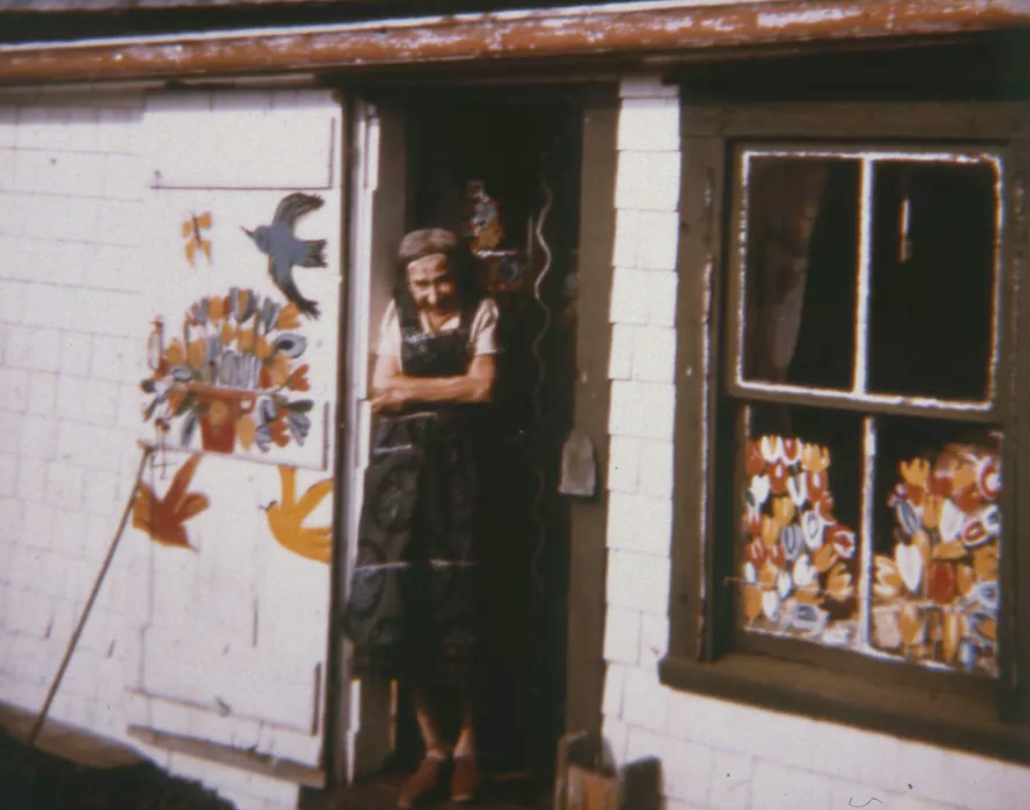Maud Lewis in front of her house, 1961. Photo by Cora Greenaway. Courtesy of the Art Gallery of Nova Scotia.
Her story begins on March 7th, 1901. Born in the Yarmouth hospital, Maud Lewis grew up in south Ohio. Lewis was born with such a rare condition that doctors had not diagnosed it in her lifetime. This condition caused her to be frail and small, have sloped shoulders, a spine that was curved, and a recessed chin. She grew up as the only daughter with an older brother. Because Lewis’s father was a blacksmith, her family was fortunate enough not to have lived in the poverty of the area.
Early on in Lewis’s life, she learned to paint, a skill she would later come to love. In 1914 her family moved to Yarmouth, Nova Scotia. Her brother was a manager of the theatre, her father ran a harness store. Lewis lived a happy life, but because of her condition, she got bullied during her youth. In the early 1920s, Lewis began selling Christmas cards and trays she painted. She first started going door to door with them, then a friend and a local businesswoman sold her paintings and painted trays. In the early 1930s, she painted commercial illustrations, where her first illustration looked similar to some of her earlier paintings. Into adulthood, Lewis was still living at home with her parents and was with a man named Emery Allen. She gave birth to a daughter, Catherine Doowley, in 1928. After Catherine’s birth, Emery left Lewis, and a couple years later, her father died in 1935, and, in 1937, her mother died. She lived with her brother until her aunt in Digby took her in. In 1937, a man named Everett Lewis put up signs looking for a housekeeper. Lewis replied, changing her life.
Although they did not click right away, the pair eventually fell in love. By 1938, they were married. On their wedding day, Everett claimed to be thirty-four although he was thirty-six. Maud eventually moved in with Everett. They lived in a small twelve-square-foot house. She and Everett were impoverished. Eventually, it came to the point where Lewis was incapable of doing chores. Due to her worsening arthritis, her hands started to get worse, eventually curling up into sealed fists, along with that she had neck and back conditions. Those conditions made her have a hard time lifting things that were heavy or prevented her from being able to climb stairs. As time passed, Lewis began to start painting again. Her paintings showed scenes from her life in Nova Scotia. These paintings included oxen, sleighs, carriages, cats, and other things. She also began to sell her paintings. She even painted her house. She painted pictures on nearly everything inside and outside of the house. She painted things from the walls to the stove and even the dustpan. Everett made sure to keep her paintings he eventually ended up putting Lewis outside to paint near the highway. His idea was that people would go by and take pity on her, and be more likely to come in to buy stuff. Everett eventually lost his job as a watchman, this caused him to make Lewis paint more. The more she kept painting, the worse her arthritis became. Despite her health conditions, Lewis’s art always managed to uplift her spirits, and so she continued to create.
In the last five years of Lewis’s life, her art began to become internationally famous, even being talked about on CBC there was even an article written about her in the Star Weekly. This article did so well that the demand for Lewis’s paintings rose. While living her final years, she had a hard time completing all the paintings people wanted. This led to Everett helping her out, at one point he even made stencils for her of the things she liked to paint. In order for Lewis to have more space to paint, she ended up working by the house in a trailer, however, in 1970, Lewis died in the hospital due to pneumonia, and had been buried in Marshalltown, whileher husband Everett, was murdered nine years later, because of a break-in. Today, the house she painted can be seen on display in a museum in Halifax. As Maud’s life came to an end, her paintings and story will continue to live on for years to come.





